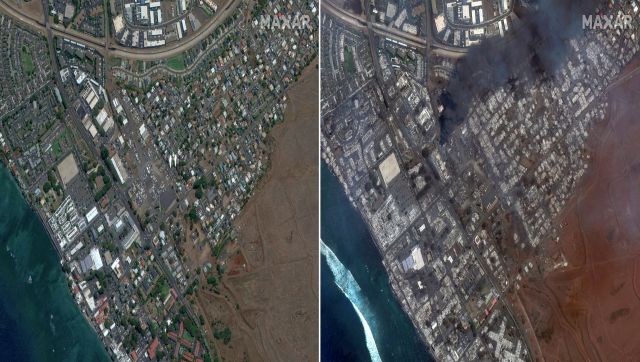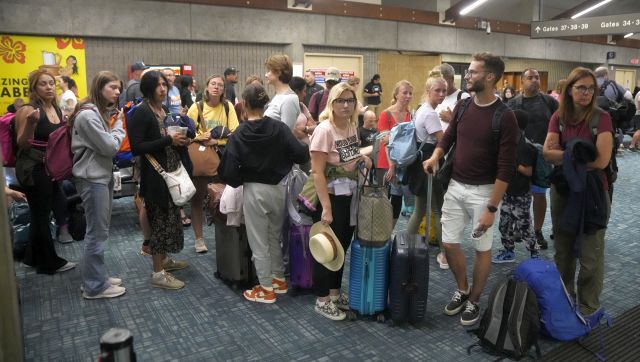Hawaii wildfire: Why the wildfires in Maui are so devastating
Thirty-six people have died and the Maui town of Lahaina has been scorched after wildfires ripped across the area. Experts say a dangerous mix of high winds, low humidity and dry vegetation, coupled with climate change fuelled the catastrophe

Fire and smoke fill the sky from wildfires on the intersection at Hokiokio Place and Lahaina Bypass in Maui, Hawaii. Wildfires in Hawaii fanned by strong winds burned multiple structures in areas including historic Lahaina town, forcing evacuations and closing schools. AP
It’s known to be the land to go to for tropical beaches. However, on Thursday (10 August), the Hawaiian town of Lahaina resembled Baghdad during the war. The town, from above, looks incinerated; one can only see charred palm trees; homes have been reduced to ashes, and streets are deserted.
The devastation is owing the what experts are now calling one the deadliest wildfire to strike Hawaii – they have already claimed 36 lives and forced the evacuation of more than 2,000 people. The Maui wildfire, which is still active according to officials, has already guzzled over 150,000 gallons of water.
But what has caused the blaze to be so deadly? While a dangerous mix of high winds, low humidity and dry vegetation is to blame, experts also say that climate change is increasing the likelihood of more extreme weather events like what’s playing out on the island of Maui.
Related Articles
“It’s leading to these unpredictable or unforeseen combinations that we’re seeing right now and that are fuelling this extreme fire weather,” said Kelsey Copes-Gerbitz, a postdoctoral researcher at the University of British Columbia;s faculty of forestry. “What these … catastrophic wildfire disasters are revealing is that nowhere is immune to the issue.”
What’s fuelling them?
Major differences in air pressure drove unusually strong trade winds that fanned the destructive flames, according to meteorologists.
Trade winds are a normal feature of Hawaii’s climate. They’re caused when air moves from the high-pressure system pressure north of Hawaii — known as the North Pacific High — to the area of low pressure at the equator, to the south of the state.
But Hurricane Dora, which passed south of the islands this week, is exacerbating the low-pressure system and increasing the difference in air pressure to create “unusually strong trade winds,” said Genki Kino, a meteorologist with the National Weather Service office in Honolulu.
Hawaii’s state climatologist, Pao-Shin Chu, said he was caught off guard by the impact Dora had from roughly 500 miles (800 kilometres) away. “Hurricane Dora is very far away from Hawaii, but you still have this fire occurrence here. So this is something we didn’t expect to see,” he said.
Strong winds, combined with low humidity and an abundance of dry vegetation that burns easily, can increase the danger of wildfire, even on a tropical island like Maui.

“If you have all of those conditions at the same time, it’s often what the National Weather Service calls ‘red flag conditions,’” said Erica Fleishman, director of the Oregon Climate Change Research Institute at Oregon State University.
Also read: Canada wildfire smoke could linger over US for days: How deadly is it?
How does climate change play a role?
“Climate change in many parts of the world is increasing vegetation dryness, in large part because temperatures are hotter,” Fleishman said. “Even if you have the same amount of precipitation, if you have higher temperatures, things dry out faster.”
Clay Trauernicht, a fire scientist at the University of Hawaii, said the wet season can spur plants like Guinea grass, a nonnative, invasive species found across parts of Maui, to grow as quickly as six inches (15 centimetres) a day and reach up to 10 feet (3 metres) tall. When it dries out, it creates a tinderbox that’s ripe for wildfire.
“These grasslands accumulate fuels very rapidly,” Trauernicht said. “In hotter conditions and drier conditions, with variable rainfall, it’s only going to exacerbate the problem.”

Does this contribute to stronger hurricanes?
Climate change not only increases the fire risk by driving up temperatures, but also makes stronger hurricanes more likely. In turn, those storms could fuel stronger wind events like the one behind the Maui fires.
That’s on top of other threats made worse by climate changes.
“There’s an increasing trend in the intensity of hurricanes worldwide, in part because warm air holds more water,” Fleishman said. “In addition to that, sea levels are rising worldwide, so you tend to get more severe flooding from the storm surge when a hurricane makes landfall.”
While climate change can’t be said to directly cause singular events, experts say, the impact extreme weather is having on communities is undeniable.
“These kinds of climate change-related disasters are really beyond the scope of things that we’re used to dealing with,” UBC’s Copes-Gerbitz said. “It’s these kind of multiple, interactive challenges that really lead to a disaster.”
With inputs from Associated Press
also read

At least six dead as wildfire razes Hawaiian town, Biden sends military to control situation
At least six people have been killed in a wildfire that has razed a Hawaiian town, officials said Wednesday, with desperate residents jumping into the ocean in a bid to escape the fast-moving flames

‘Era of global boiling’: Who are chief heat officers and can they tackle extreme temperatures?
It’s been an excruciating summer affecting large parts of Asia, North America, Europe, and Africa. The climate crisis has given birth to a new phenomenon – chief heat officers. So far, the world has less than ten of them. Can they make a difference?

Climate change will affect your pets. Here's how you can take care of them
Climate change will harm animals both wild and domesticated, including pets. Here's a a look at how various types of pets will fare in a warming world – and how we can help them


